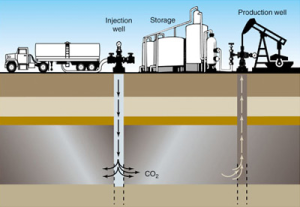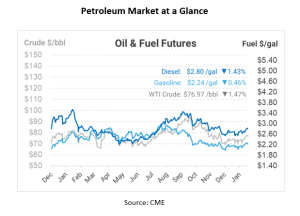
What Is That Wednesday – Enhanced Oil Recovery (EOR)
In the world of oil production, a new technology has emerged called Enhanced Oil Recovery (EOR). This innovative process is unlocking new potentials in resource management, economic stability, and environmental responsibility. Its growing influence on market dynamics and environmental strategies positions it as a pillar in the future of energy. Today’s What Is That Wednesday will cover the intricacies of EOR, what you need to know about it as a fuel buyer, and future implications to be aware of.
What is Enhanced Oil Recovery?
Enhanced Oil Recovery is a set of techniques used to increase the amount of crude oil that can be extracted from an oil field. Traditional methods, like primary and secondary recovery, leave a substantial amount of oil in the reservoir. EOR steps in to extend the life of existing oil fields and maximize oil extraction. There are three main types of EOR:
Thermal Recovery: This method involves introducing heat, typically steam, into the reservoir to lower the viscosity of the oil, making it easier to extract.
Gas Injection: Here, gases like carbon dioxide or nitrogen are injected into the reservoir. These gases mix with the oil, expand it, and push it towards the production wells. Carbon dioxide Enhanced Oil Recovery (CO2-EOR) is emerging as the most popular method in the field. Initially, this technique utilized naturally occurring carbon dioxide deposits, but advancements have led to the development of technologies that repurpose CO2 generated as industrial byproducts for injection.

Source: Lawrence Livermore National Laboratory
Chemical Injection: In this method, chemicals like polymers are injected to increase the efficiency of the water flooding process or to change the properties of the oil, making it easier to extract.
Why You Need to Know About EOR
EOR stands as a key player in resource optimization. By utilizing EOR techniques, the industry ensures a more efficient and effective use of natural resources. This efficiency is not just beneficial in terms of resource management but also plays a role in the economic landscape of the oil market. EOR has the capability to alter oil prices significantly. By boosting the supply of oil from fields that were once considered to be on the brink of exhaustion or economically unviable, EOR can lead to a more stable and potentially lower price for oil products. This aspect is particularly important for buyers whose business models or operational costs are closely tied to the fluctuations in oil prices. In a market where price volatility can have substantial impacts, understanding how EOR contributes to supply dynamics is indispensable.
EOR techniques, particularly CO2 injection, play a pivotal role in both improving oil recovery rates and supporting environmental initiatives. This method involves the utilization of carbon dioxide, a significant greenhouse gas, in the extraction of oil. Its dual advantage lies in boosting oil recovery while concurrently sequestering CO2. This not only reduces atmospheric pollution but also aligns with global efforts to diminish carbon footprints and tackle climate change. For those purchasing oil products, this aspect of EOR adds a dimension of environmental responsibility, enabling them to contribute to a balance between economic demands and ecological preservation.
Future Implications for EOR
The U.S. Department of Energy (DOE) is instrumental in the progression of EOR technologies. Their strategy extends beyond merely enhancing oil extraction; it encompasses the development of methods that are both environmentally sustainable and economically feasible. This involves a commitment to innovating in the field of EOR. The DOE’s research and support are geared towards creating more efficient chemical agents, refining thermal recovery methods, and enhancing gas injection techniques.
A particular focus area is the integration of EOR with carbon capture and storage (CCS) technologies. This synergy not only aids in extracting oil but also effectively stores CO2 underground, directly contributing to the mitigation of climate change impacts. The DOE’s approach carefully balances the economic advantages of EOR with environmental stewardship, striving for techniques that offer economic viability without compromising ecological integrity.
The DOE actively collaborates with various sectors, including industry, academia, and other government agencies, to advance EOR technologies. They are also involved in shaping policies that foster the adoption of EOR methods that are both efficient and environmentally friendly. This comprehensive approach by the DOE ensures that EOR technologies not only meet current needs but are also sustainable and responsible in the long term.

This article is part of Uncategorized
Tagged:
MARKET CONDITION REPORT - DISCLAIMER
The information contained herein is derived from sources believed to be reliable; however, this information is not guaranteed as to its accuracy or completeness. Furthermore, no responsibility is assumed for use of this material and no express or implied warranties or guarantees are made. This material and any view or comment expressed herein are provided for informational purposes only and should not be construed in any way as an inducement or recommendation to buy or sell products, commodity futures or options contracts.





